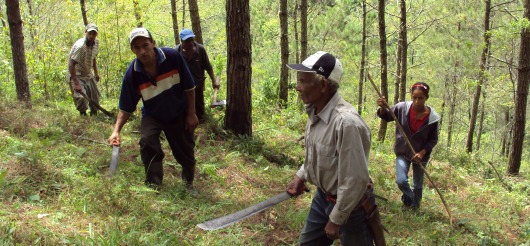Natural forests are forests that have regenerated naturally; they are composed of all the species (e.g. trees and other plants, fauna and fungi), that occur naturally in them. Natural-forest silviculture can be defined as the practice of controlling the establishment, growth, composition, health and quality of natural forests to meet diverse needs and values. Silvicultural practice consists of the interventions applied to forests to maintain or enhance their utility for specific purposes, such as the production of wood and other forest products, biodiversity conservation, recreation and the provision of environmental services.
Decisions on silviculture in natural forests can occur at three levels: silvicultural systems; silvicultural treatment regimes; and silvicultural operations.
- A silvicultural system is “the process by which the crops constituting a forest are tended, removed and replaced by new crops, resulting in the production of stands of distinctive form ... The terms ‘stand’ and ‘crop’ are both used to denote silvicultural or management units that are homogeneous in one or several aspects” (Matthews 1994).
- A silvicultural treatment is a planned programme of silvicultural operations that can be implemented during the entire or partial rotation of a stand. Within the context of silvicultural stand treatment, each stand is assigned a specific silvicultural objective and separately assessed for the characteristics of its site (e.g. locality, slope and soil type) and stocking (e.g. composition, age, diameter distribution and regeneration). Based on this information, a silvicultural treatment regime is formulated.
- Silvicultural operations are procedures that aim to achieve stand-specific objectives by using silvicultural techniques. Such techniques include, for example, canopy alterations to induce natural regeneration, the harvesting of mature trees, planting, and thinning to improve timber quality and stand growth. Silvicultural operations involve decisions on machinery and other equipment, techniques, work organization and human resources, as well as considerations of operational cost and investment.
Silvicultural systems usually develop as a response to the practical need to balance market, socioeconomic and ecological requirements in a technically feasible way. Silvicultural systems in natural forests can be categorized broadly as either monocyclic (“uniform”, “even-aged”) or polycyclic (“selective”, “uneven-aged”). Monocyclic systems involve harvesting all marketable timber in a single felling operation, and the length of the cycle is more or less equal to the rotation age of the species under exploitation. Clearcutting is the most obvious example of a monocyclic system, and the Malayan Uniform System (which is not a clearcutting system) is a monocyclic system that has been used successfully in some tropical forests. Polycyclic systems involve the harvesting of trees in a continual series of felling cycles; selection cutting using a minimum diameter for harvesting is a common method. The length of these felling cycles is usually about half the time required for a particular species to reach marketable size.
There are many variations of these two systems, depending on biological, ecological, economic and administrative conditions and silvicultural goals. An important difference between them is that polycyclic systems rely on the existing stock of seedlings, saplings and poles in the forest to produce the next harvestable crop, whereas monocyclic systems generally do not make use of existing stock, instead relying on seedlings recruited after felling to produce the next crop of trees.
Silvicultural interventions should be planned in accordance with the management objectives of the forest and as specified in the forest management plan. In forests managed for wood production, silvicultural interventions may be necessary to address the relative depletion of commercial tree species caused by past logging interventions, to increase the growth of commercial species, and to optimize the commercial value of the forest. The intensity of interventions will vary depending on, for example, accessibility, markets, site quality, management objectives and ownership.
In planning silvicultural interventions, forest managers should ensure they have adequate biological and socioeconomic information on the forest (see Forest Inventory), as well as sufficient knowledge of operational aspects such as weather, access, funding and human resources. Forest managers should also have a good understanding of the ecology of the forests in which interventions are planned, especially the structure of the existing stand and the requirements for ensuring the adequate regeneration of desirable species.



